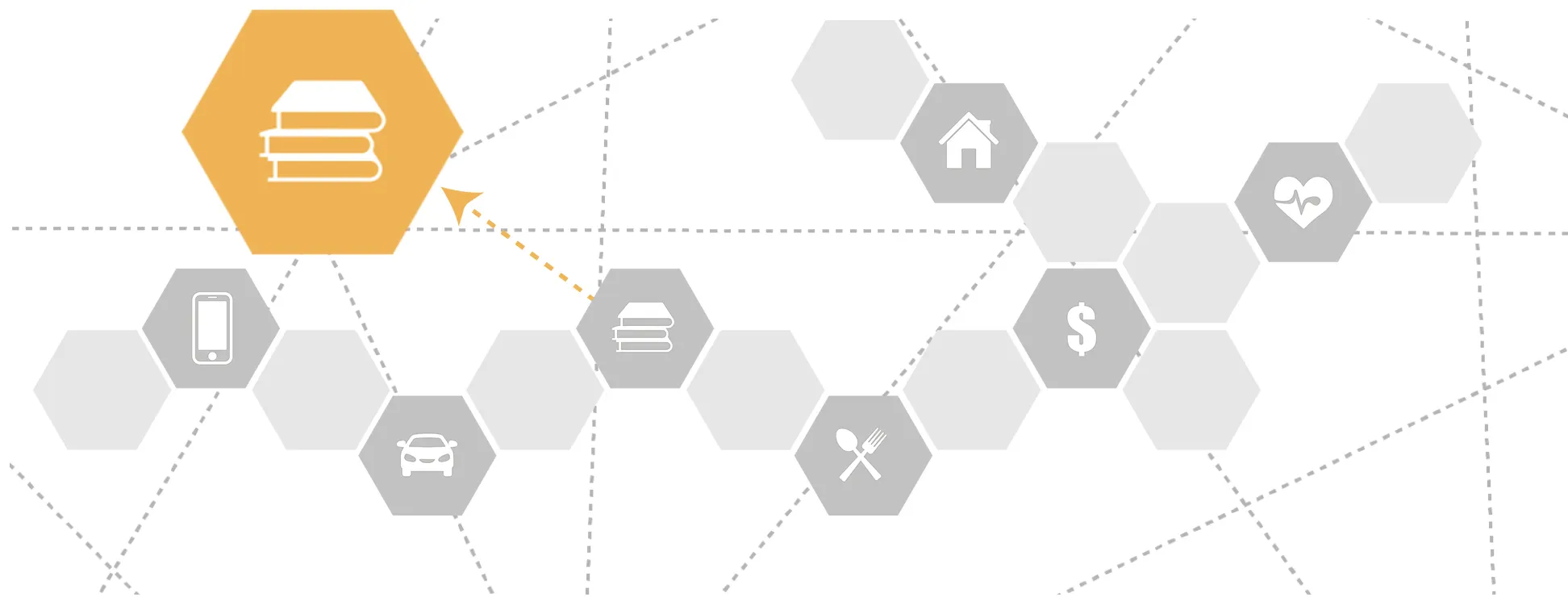
|
Housingclick to view |

|
Health Careclick to view |

|
Child Care and Educationclick to view |

|
Technologyclick to view |

|
Foodclick to view |

|
Taxesclick to view |

|
Transportationclick to view |
||
Impact on ALICE • Higher Education
Income is highly correlated with education level. Nationally, the difference in lifetime earnings between high school graduates and those who hold a bachelor’s degree is estimated to be $830,800. Yet higher education is out of reach for many Americans. About 70 percent of low-income students attend college immediately after high school, compared to 80 percent of children from high-income families.43
Students in ALICE families encounter numerous obstacles to attaining higher education, including:
- Affordability of tuition, housing, books, supplies, transportation, and “hidden costs” such as technology and college fees
- Difficulty navigating financial aid and other available resources
- A steep educational, institutional, and social learning curve, especially for first-generation college students
- Limited geographic mobility (students may not be able to move away from home to attend college, even if accepted) 44
- Inadequate K-12 preparation (deficiencies in core areas, such as reading, writing, and math)
- Balancing work and study (if students need to work to make ends meet)
- Physical, emotional, and cognitive effects of debt 45
Education Attainment and Median Annual Earnings, U.S., 2017

Source: American Community Survey. (2017). 1-, 3-, and 5-year estimates
What do families do if they can't afford college?
Not Attend College
While more students from low-income families are going to college, they still lag behind students from wealthier families. Among recent high school graduates from families earning below $30,000 per year, 63 percent enrolled in a college in 2016, compared to 82 percent of students from families earning above $100,000 per year.46 And for many ALICE families, college is still completely out of reach.
While more students from low-income families are going to college, they still lag behind students from wealthier families. Among recent high school graduates from families earning below $30,000 per year, 63 percent enrolled in a college in 2016, compared to 82 percent of students from families earning above $100,000 per year.46 And for many ALICE families, college is still completely out of reach.

Work or Take out a Student Loan
Attend Community/For-Profit College
Students from low-income families are more likely than their wealthier peers to attend two-year community colleges or private for-profit colleges, in associate degree or certificate programs. Low-income students made up half of students at public two-year colleges and 61 percent at private for-profit institutions compared to only 27 percent at private nonprofit four-year colleges.61 While community colleges often provide a vital lifeline for low-income students, both two-year and for-profit colleges can have drawbacks.
Students from low-income families are more likely than their wealthier peers to attend two-year community colleges or private for-profit colleges, in associate degree or certificate programs. Low-income students made up half of students at public two-year colleges and 61 percent at private for-profit institutions compared to only 27 percent at private nonprofit four-year colleges.61 While community colleges often provide a vital lifeline for low-income students, both two-year and for-profit colleges can have drawbacks.

Sources
43
Burdick-Will, J. (2015). Johns Hopkins sociologist challenges common assumptions about school choice. Retrieved from http://hub.jhu.edu/2015/09/02/sociology-school-choice/
44
Carnevale, A. P., & Smith, N. (2018). Balancing work and learning: Implications for low-income students. Georgetown University, Center on Education and the Workforce. Retrieved from https://1gyhoq479ufd3yna29x7ubjn-wpengine.netdna-ssl.com/wp-content/uploads/Low-Income-Working-Learners-FR.pdf
Carnevale, A., Rose, S., & Cheah, B. (2014). The college payoff: Education, occupations, lifetime earnings. Georgetown University, Center on Education and the Workforce. Retrieved from https://cew.georgetown.edu/wp-content/uploads/2014/11/collegepayoff-complete.pdf
45
Shanks, T. R. (2011, October). Over stressed kids: Examining the impact of economic insecurity on children and families. The Annie E. Casey Foundation. Retrieved from https://www.aecf.org/m/resourcedoc/aecf-OverStressedKids-2011.pdf#page=7
46
Cooper, P. (2018, February 26). College enrollment surges among low-income students. Forbes. Retrieved from https://www.forbes.com/sites/prestoncooper2/2018/02/26/college-enrollment-surges-among-low-income-students/#2c935a4293b9
Desilver, D. (2014, January 15). College enrollment among low-income students still trails richer groups. Pew Research Center. Retrieved from https://www.pewresearch.org/fact-tank/2014/01/15/college-enrollment-among-low-income-students-still-trails-richer-groups/
47
Abel, J., Deitz, R., & Su, Y. (2014). Are recent college graduates finding good jobs? Current Issues in Economics and Finance, 20(1), 1–8. Retrieved from http://www.newyorkfed.org/research/current_issues/ci20-1.pdf
48
Pew Research Center. (2014). The rising cost of not going to college, Chapter 1: Education and economic outcomes among the young. Retrieved from http://www.pewsocialtrends.org/2014/02/11/chapter-1-education-and-economic-outcomes-among-the-young/
49
U.S. Census Bureau. (2018, September 12). Income and poverty in the United States: 2017. Retrieved from https://www.census.gov/library/publications/2018/demo/p60-263.html
50
Center on Society and Health. (2015). Why education matters to health: Exploring the causes. Retrieved from https://societyhealth.vcu.edu/work/the-projects/why-education-matters-to-health-exploring-the-causes.html
Zimmerman, E. B., Woolf, S. H., & Haley, A. (2015). Understanding the relationship between education and health: A review of the evidence and an examination of community perspectives. In Kaplan R, Spittel M, David D (Eds), Population Health: Behavioral and Social Science Insights. AHRQ Publication No. 15-0002, pp. 347-384. Rockville, MD: Agency for Healthcare Research and Quality and Office of Behavioral and Social Sciences Research, National Institutes of Health; July 2015. https://www.researchgate.net/profile/Michael_Spittel/publication/311734534_Population_Health_Behavioral_and_Social_Science_Insights/links/58582f3c08aeffd7c4fbb370/Population-Health-Behavioral-and-Social-Science-Insights.pdf#page=357
51
Institute for Women’s Policy Research. (2013). College students with children are common and face many challenges in completing higher education. Retrieved from http://files.eric.ed.gov/fulltext/ED556715.pdf
52
Spaulding, S., Derrick-Mills, T., & Callan, T. (2016, January). Supporting parents who work and go to school. Urban Institute. Retrieved from https://www.urban.org/sites/default/files/publication/76796/2000575-supporting-parents-who-work-and-go-to-school-a-portrait-of-low-income-students-who-are-employed.pdf
53
ABODO. (2017, May 25). The old college try: A look at working students across the country. Retrieved from https://www.abodo.com/blog/old-college-try/HSBC. (2018). The value of education, the price of success. Retrieved from https://www.us.hsbc.com/content/dam/hsbc/us/en_us/value-of-education/HSBC_VOE5_USA_FactSheet_508r2.pdf
54
Goldrick-Rab, S., Baker-Smith, C., Coca, V., Looker, E., & Williams, T. (2019, April). College and university basic needs insecurity: A national #RealCollege survey report. The Hope Center. https://hope4college.com/wp-content/uploads/2019/04/HOPE_realcollege_National_report_digital.pdf
55
The Institute for College Access & Success. (2018, September 19). Student debt and the Class of 2017. Retrieved from https://ticas.org/content/pub/student-debt-and-class-2017
56
Matthiessen, C. (2019, January 9). Why are so many college students returning home? GreatSchools.org. Retrieved from https://www.greatschools.org/gk/articles/dropping-out-of-college-record-numbers/
57
The Institute for College Access & Success. (2018, September 19). Student debt and the Class of 2017. Retrieved from https://ticas.org/content/pub/student-debt-and-class-2017
58
The Institute for College Access & Success. (2018, September 19). Student debt and the Class of 2017. Retrieved from https://ticas.org/content/pub/student-debt-and-class-2017
59
Goldrick-Rab, S., Baker-Smith, C., Coca, V., Looker, E., & Williams, T. (2019, April). College and university basic needs insecurity: A national #RealCollege survey report. The Hope Center. https://hope4college.com/wp-content/uploads/2019/04/HOPE_realcollege_National_report_digital.pdf
60
Lew, I. (2015, November). Student loan debt and the housing decisions of young households (Research Brief). Joint Center for Housing Studies of Harvard University. Retrieved from https://www.jchs.harvard.edu/research-areas/working-papers/student-loan-debt-and-housing-decisions-young-households
Summer and Student Debt Crisis. (2018, November 1). Buried in debt: A national survey report on the state of student loan borrowers in 2018. Retrieved from https://www.meetsummer.org/share/Summer-Student-Debt-Crisis-Buried-in-Debt-Report-Nov-2018.pdf
61
Fry, R., & Cilluffo, A. (2019, May 22). A rising share of undergraduates are from poor families, especially at less selective colleges. Pew Research Center. Retrieved from https://www.pewsocialtrends.org/2019/05/22/a-rising-share-of-undergraduates-are-from-poor-families-especially-at-less-selective-colleges/
62
American Community Survey. (2017). 2017; 1-, 3-, and 5-Year estimates. Retrieved from U.S. Census Bureau: http://factfinder2.census.gov/faces/nav/jsf/pages/searchresults.xhtml?refresh=t
63
Levesque, E. M. (2018, October 8). Improving community college completion rates by addressing structural and motivational barriers. Brookings. Retrieved from https://www.brookings.edu/research/community-college-completion-rates-structural-and-motivational-barriers/
64
Cellini, S. R., & Turner, N. (2016, May; revised January 2018). Gainfully employed? Assessing the employment and earnings of for-profit college students using administrative data (NBER Working Paper No. 22287). The National Bureau of Economic Research. https://www.nber.org/papers/w22287?utm_campaign=ntw&utm_medium=email&utm_source=ntw


